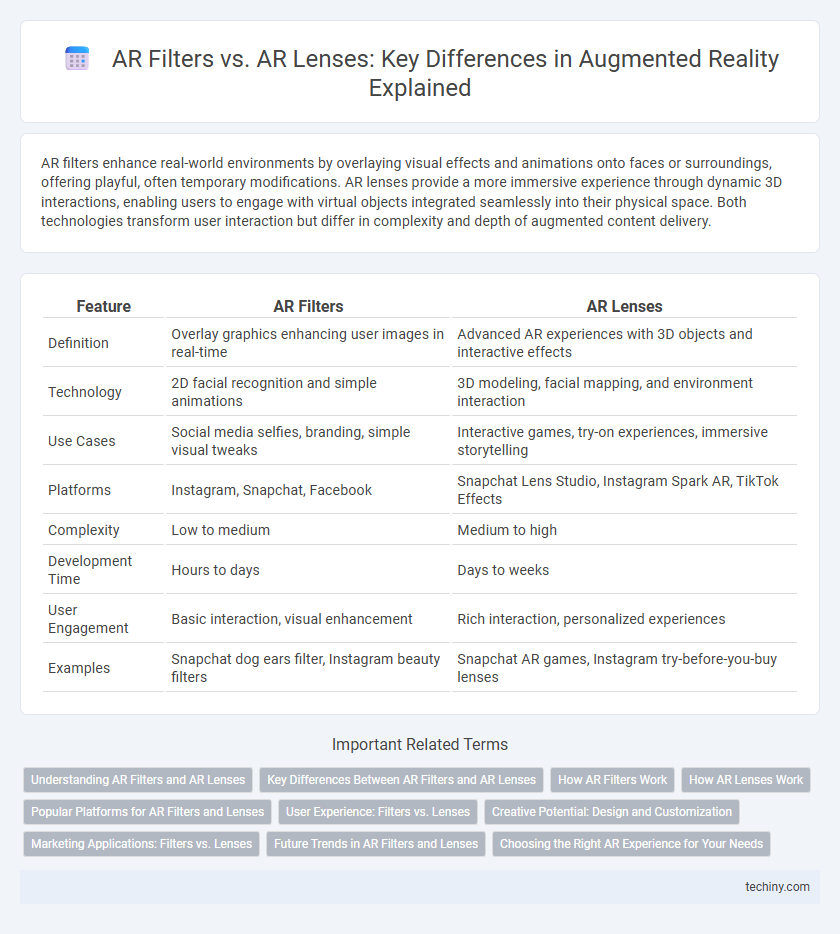AR filters enhance real-world environments by overlaying visual effects and animations onto faces or surroundings, offering playful, often temporary modifications. AR lenses provide a more immersive experience through dynamic 3D interactions, enabling users to engage with virtual objects integrated seamlessly into their physical space. Both technologies transform user interaction but differ in complexity and depth of augmented content delivery.
Table of Comparison
| Feature | AR Filters | AR Lenses |
|---|---|---|
| Definition | Overlay graphics enhancing user images in real-time | Advanced AR experiences with 3D objects and interactive effects |
| Technology | 2D facial recognition and simple animations | 3D modeling, facial mapping, and environment interaction |
| Use Cases | Social media selfies, branding, simple visual tweaks | Interactive games, try-on experiences, immersive storytelling |
| Platforms | Instagram, Snapchat, Facebook | Snapchat Lens Studio, Instagram Spark AR, TikTok Effects |
| Complexity | Low to medium | Medium to high |
| Development Time | Hours to days | Days to weeks |
| User Engagement | Basic interaction, visual enhancement | Rich interaction, personalized experiences |
| Examples | Snapchat dog ears filter, Instagram beauty filters | Snapchat AR games, Instagram try-before-you-buy lenses |
Understanding AR Filters and AR Lenses
AR Filters enhance real-world environments by overlaying graphics, effects, or animations onto a user's view, typically through social media apps like Instagram or Snapchat. AR Lenses provide more interactive, immersive experiences by transforming facial features or surroundings with 3D objects and real-time tracking technology. Both tools leverage computer vision and sensor data but differ in complexity and user engagement.
Key Differences Between AR Filters and AR Lenses
AR filters primarily alter the appearance of a user's face or environment by overlaying graphics or effects, whereas AR lenses offer a deeper interactive experience by integrating 3D objects and animations into the user's surroundings. Filters are typically simpler, focusing on color changes, masks, or textures, while lenses enable immersive augmented reality experiences with real-time tracking and dynamic content. These key differences influence platform compatibility, user engagement, and technical complexity in AR application development.
How AR Filters Work
AR filters utilize real-time image recognition and tracking technology to overlay digital effects onto users' faces or environments, enhancing visual experiences in social media apps like Instagram and Snapchat. These filters map facial features or background elements by detecting key points and applying graphical modifications such as color changes, animations, or 3D objects. Advanced AR filters leverage machine learning algorithms to improve accuracy and responsiveness, creating immersive and interactive user engagements.
How AR Lenses Work
AR lenses function by using advanced computer vision and facial recognition technology to detect and map facial features in real time, enabling dynamic overlays that adapt to user movements and expressions. These lenses employ depth sensors and 3D modeling to create immersive, interactive effects that blend seamlessly with the physical environment. Unlike static AR filters, AR lenses offer personalized augmented experiences by continuously tracking facial geometry and environmental cues for precision alignment.
Popular Platforms for AR Filters and Lenses
Popular platforms for AR filters include Instagram and Snapchat, which offer extensive libraries of user-generated and branded filters that enhance social media engagement. Snapchat specializes in AR lenses with advanced facial recognition and interactive features, making it a leader in immersive, real-time experiences. Instagram provides a more accessible platform for creators to develop and share AR filters using Spark AR Studio, driving widespread adoption across its global user base.
User Experience: Filters vs. Lenses
AR filters typically overlay effects that enhance or alter a user's appearance or environment with simple, visually engaging elements, creating an accessible and intuitive user experience. AR lenses offer more immersive, interactive experiences by integrating 3D objects and animations that respond dynamically to user movements and surroundings, elevating engagement and realism. The choice between AR filters and lenses hinges on desired interaction depth, with filters favoring quick enhancements and lenses delivering complex, spatially aware experiences.
Creative Potential: Design and Customization
AR Filters offer a versatile platform for creative expression, enabling users to easily apply predefined visual effects that enhance real-time imagery with minimal customization. AR Lenses provide deeper design complexity and customization options, allowing creators to build immersive experiences that interact dynamically with the environment and user actions. The greater creative potential of AR Lenses lies in their ability to incorporate 3D elements, advanced animations, and interactive features that elevate user engagement beyond simple overlays.
Marketing Applications: Filters vs. Lenses
AR filters offer customizable overlays that enhance brand visibility by enabling users to interact with branded content in social media stories, driving engagement and user-generated promotion. AR lenses provide immersive, dynamic experiences by integrating 3D effects and facial tracking, making them powerful tools for experiential marketing campaigns that foster deeper emotional connections. Brands leveraging AR lenses typically see higher user retention and richer data insights, while filters excel in rapid deployment and wide audience reach.
Future Trends in AR Filters and Lenses
AR filters are evolving with enhanced interactivity, incorporating AI-driven facial recognition and real-time environmental mapping to create more immersive user experiences. AR lenses are expected to integrate advanced spatial computing, enabling precise object placement and multi-sensory feedback that bridges virtual and physical worlds seamlessly. The future of AR filters and lenses lies in personalized, context-aware applications across social media, retail, and healthcare, leveraging 5G connectivity and edge computing for low-latency performance.
Choosing the Right AR Experience for Your Needs
AR filters typically enhance real-world environments with graphics or effects overlaid on the camera view, ideal for social media interactions and casual engagement. AR lenses offer a more immersive experience by integrating 3D objects or animations that interact dynamically with the user's surroundings, suitable for branding or interactive marketing campaigns. Selecting the right AR experience depends on your goals: filters for quick engagement and fun interactions, lenses for deeper storytelling and user involvement.
AR Filters vs AR Lenses Infographic

 techiny.com
techiny.com